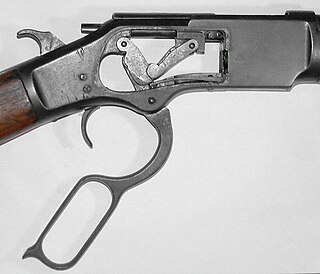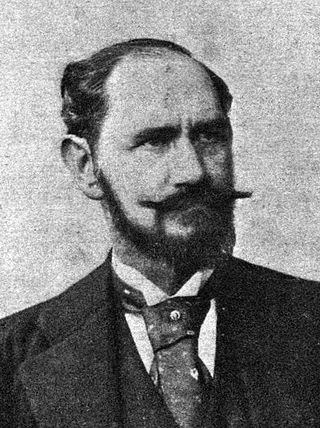
In firearm designs, the term single-shot refers to guns that can hold only a single round of ammunition inside and thus must be reloaded manually after every shot. Compared to multi-shot repeating firearms ("repeaters"), single-shot designs have no moving parts other than the trigger, hammer/firing pin or frizzen, and therefore do not need a sizable receiver behind the barrel to accommodate a moving action, making them far less complex and more robust than revolvers or magazine/belt-fed firearms, but also with much slower rates of fire.

Bolt-action is a type of manual firearm action that is operated by directly manipulating the bolt via a bolt handle, which is most commonly placed on the right-hand side of the firearm.

In firearms terminology, an action is the functional mechanism of a breech-loading firearm that handles the ammunition cartridges, or the method by which that mechanism works. Actions are technically not present on muzzleloaders, as all those are single-shot firearms with a closed off breech with the powder and projectile manually loaded from the muzzle. Instead, the muzzleloader ignition mechanism is referred to as the lock.
A semi-automatic firearm, also called a self-loading or autoloading firearm, is a repeating firearm whose action mechanism automatically loads a following round of cartridge into the chamber and prepares it for subsequent firing, but requires the shooter to manually actuate the trigger in order to discharge each shot. Typically, this involves the weapon's action utilizing the excess energy released during the preceding shot to unlock and move the bolt, extracting and ejecting the spent cartridge case from the chamber, re-cocking the firing mechanism, and loading a new cartridge into the firing chamber, all without input from the user. To fire again, however, the user must actively release the trigger, allow it to "reset", before pulling the trigger again to fire off the next round. As a result, each trigger pull only discharges a single round from a semi-automatic weapon, as opposed to a fully automatic weapon, which will shoot continuously as long as the ammunition is replete and the trigger is kept depressed.

A lever action is a type of action for repeating firearms that uses a manually operated cocking handle located around the trigger guard area that pivots forward to move the bolt via internal linkages, which will feed and extract cartridges into and out of the chamber, and cock the firing pin mechanism. This contrasts to other type of repeating actions such as the bolt-action, pump-action, semi-automatic, fully automatic, and/or burst mode actions. A firearm using this operating mechanism is colloquially referred to as a levergun.
Savage Arms is an American gunmaker based in Westfield, Massachusetts, with operations in Canada and China, PRC. Savage makes a variety of rimfire and centerfire rifles, as well as Stevens single-shot rifles and shotguns. The company is best known for the Model 99 lever-action rifle, no longer in production, and the .300 Savage. Savage was a subsidiary of Vista Outdoor until 2019 when it was spun off.

The Gewehr 98 is a bolt-action rifle made by Mauser for the German Empire as its service rifle from 1898 to 1935.

The M1895 Lee Navy was a straight-pull magazine rifle adopted in limited numbers by the U.S. Navy and Marine Corps in 1895 as a first-line infantry rifle. The Navy's official designation for the Lee Straight-Pull rifle was the "Lee Rifle, Model of 1895, caliber 6-mm" but the weapon is also largely known by other names, such as the "Winchester-Lee rifle", "Lee Model 1895", "6mm Lee Navy", and "Lee Rifle, Model of 1895".

Ferdinand Ritter von Mannlicher was an Austrian engineer and small arms designer. Along with James Paris Lee, Mannlicher was particularly noted for inventing the en-bloc clip charger-loading box magazine system. Later, while making improvements to other inventors' prototype designs for rotary-feed magazines, Mannlicher, together with his protégé Otto Schönauer, patented a perfected rotary magazine design, the Mannlicher–Schönauer rifle, which was a commercial and military success.

The M1917 Enfield, the "American Enfield", formally named "United States Rifle, cal .30, Model of 1917" is an American modification and production of the .303-inch Pattern 1914 Enfield (P14) rifle, which was developed and manufactured during the period 1917–1918. Numerically, it was the main rifle used by the American Expeditionary Forces in Europe during World War I. The Danish Sirius Dog Sled Patrol on Greenland still use the M1917, which performs reliably in Arctic conditions, as their service weapon.
The Pattern 1913 Enfield (P'13) was an experimental rifle developed by the Royal Small Arms Factory for the British Army as a result of its combat experience in the Second Boer War from 1899 to 1902. The weapon was to serve as a replacement for the Short Magazine Lee–Enfield (SMLE). An advanced chamber design allowed for a high-velocity .276 Enfield rimless round, which was more powerful than the service-issued .303 British cartridge. Introduction of the P'13 was rendered impractical by the outbreak of the First World War.

The Remington Model 14 was a pump-action repeating rifle designed for the Remington Arms company by John Pedersen. It is part of a series of rifles that include the Remington Model 14-1/2 and the Remington Model 141.
The Winchester Model 1894 rifle is a lever-action repeating rifle that became one of the most famous and popular hunting rifles of all time. It was designed by John Browning in 1894 and originally chambered to fire two metallic black powder cartridges, the .32-40 Winchester and .38-55 Winchester. It was the first rifle to chamber the smokeless powder round, the .30 WCF in 1895. In 1901, Winchester created the new .32 Winchester Special caliber with production of rifles starting in 1902.
The Savage Model 99, Model 1899, and their predecessor the model 1895 are a series of hammerless lever action rifles created by the Savage Arms Company in Utica, New York. The Model 99 family featured a unique rotary magazine, and later added some detachable magazine models. The rifle was extremely popular with big game hunters and was even issued to the Montreal Home Guard during the First World War.
The Remington Model 30 is a US sporting rifle of the inter-war period based on the military P14/M1917 Enfield rifle action, which was manufactured for the British and US governments during World War I. Initial specimens used surplus military parts with some modifications in order to consume the stock of parts, though further modifications were made as production progressed and later rifles were produced from newly manufactured parts. Most early rifles were in the military .30-06 calibre used in the M1917 but it became available in a variety of chamberings. It was the first high-powered bolt-action sporting rifle produced by Remington. Some would beg to differ as Remington made the Remington Lee factory sporting rifle from 1899-1909, 1446 were built in a variety of calibers.
TOZ rifles are a family of .22 Long Rifle bolt-action cadet rifles manufactured by the Tula Arms Plant. Most notably the TOZ-8, TOZ-17 and TOZ-78 which were used to train generations of Russian military, paramilitary and police cadets.
The Winchester Model 52 was a bolt-action .22-caliber target rifle introduced by the Winchester Repeating Arms Company in 1920. For many years it was the premier smallbore match rifle in the United States, if not the world. Known as the "King of the .22s," the Model 52 Sporter was ranked by Field & Stream as one of "the 50 best guns ever made" and described by Winchester historian Herbert Houze as "perfection in design." However, by the 1970s the World War I-era design was showing its age and had given way in top-level competition to newer match rifles from Walther and Anschütz; the costly-to-produce Model 52, which had long been a loss leader prestige product by that time, was finally discontinued when US Repeating Arms took over the manufacture of Winchester rifles from Olin Corporation in 1980.
The Mauser M 98 are a series of currently (2020) produced bolt-action hunting rifles. The production of the controlled round feed Mauser 98 bolt action system for the German military ceased at the end of World War II in 1945. The new Mauser M 98 and M 98 Magnum rifles for civil users are in production since 1999 in Isny im Allgäu, Germany by Mauser Jagdwaffen GmbH, according to original drawings of 1936 and the respective Mauser patents. Mauser Jagdwaffen GmbH is a subsidiary of SIG Sauer.
The Ruger American Rifle is a family of budget-level hunting/sporting bolt-action centerfire rifle made by Sturm, Ruger & Co., which also produces a line of rimfire rifles with similar designs called the Ruger American Rimfire.

A cadet rifle is a rifle used by military cadets and others for basic firearms and marksmanship training. Generally .22 caliber and bolt-action, they also come in semi-automatic versions. They are often miniature .22 caliber versions of standard issue service rifles.









